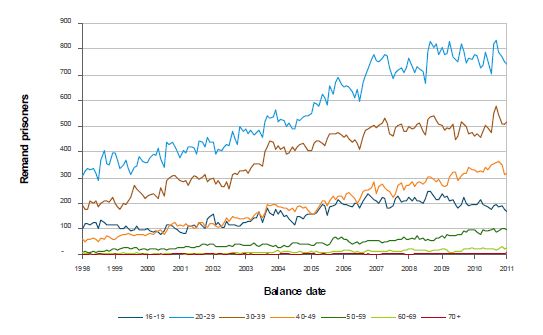5 Prison remand snapshots
5.1 Overview
Remand prisoners are held in prison while awaiting a hearing or trial, or prior to sentencing. The remand population is around 20 percent of the prison population.
Episodes of time on remand can be punctuated with multiple moves between Police, Courts, and the Department of Corrections (and, occasionally, psychiatric facilities). When an offender is sentenced to imprisonment, time spent on remand is deducted from the sentence time remaining to serve.
The information reported is based on the applicable status of the prisoner on any given day. A remand status applies irrespective of whether the remand time contributes to discharging the subsequently imposed sentence.
Information on remand prisoners is presented only from 1998 onwards.
5.2 Overall trend

For more details see: Data Spreadsheet
The number of prisoners held in custody on remand has increased over time. This is influenced by many factors, including the proportion of offenders remanded in custody and the average time spent on remand.
5.3 Gender

For more details see: Data Spreadsheet, Gender - 12 Data definitions and groupings
5.4 Age

For more details see: Data Spreadsheet, Age - 12 Data definitions and groupings
The number of prisoners on remand has increased over time for all age groups. The largest increases have been observed in the 20-29, 30-39, and 40-49 age groups. The number of 16-19 year old prisoners on remand has decreased over the last few years.
5.5 Ethnicity

For more details see: Data Spreadsheet, Ethnicity - 12 Data definitions and groupings
The over-representation of Mâori in the remand population appears to be more pronounced than in the sentenced population (see Figure 3.5).
5.6 Offence group (as charged)

For more details see: Data Spreadsheet, Offence grouping - 12 Data definitions and groupings
Numbers in remand charged in relation to violent offending, burglary, theft, and fraud, and good order offences have increased, particularly in recent years.
5.7 Median length of stay to date (in days)

For more details see: Data Spreadsheet
The median duration of prisoners’ time on remand has increased. This increase can be attributed to a number of factors but, in particular, growth in the number of cases coming before the courts has placed pressures on the system, leading to an increase in time taken to complete cases.
5.8 Length of stay to date (in months)

For more details see: Data Spreadsheet
Though difficult to discern from this figure, the overlapping lines indicate that an increasing number of prisoners are being kept in remand for longer periods. At 30 June 2011, over 250 people were in remand that had been there for longer than 6 months. This is four times the number compared with 10 years earlier.
5.9 Gender, ethnicity and age on 30 June 2011

For more details see: Data Spreadsheet, Age - 12 Data definitions and groupings
5.10 Offence group (as charged) and age

For more details see: Data Spreadsheet, Age - 12 Data definitions and groupings
5.11 Major previous sanction (ever) on 30 June 2011

For more details see: Data Spreadsheet, Major management category - 12 Data definitions and groupings
The major previous sanction indicates the major category of management ever imposed on the prisoner (not just immediately prior) before starting the current episode of remand. Relatively few (250) remand prisoners had never been under the Department’s sentence management before, and 64 percent of remand prisoners had previously served a prison sentence.

